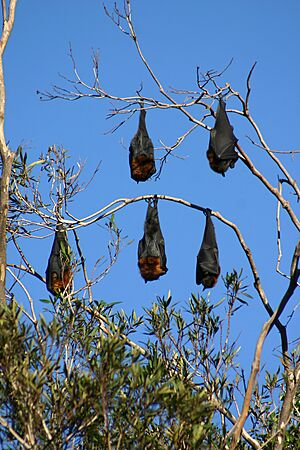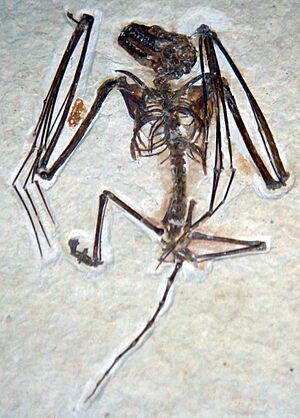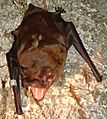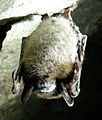Bat facts for kids
Quick facts for kids BatsTemporal range:
Upper Palaeocene – Recent |
|
|---|---|
 |
|
| Townsend's big-eared bat Corynorhinus townsendii |
|
| Scientific classification | |
| Kingdom: | |
| Phylum: | |
| Class: | |
| Infraclass: | |
| Superorder: | |
| Order: |
Chiroptera
Blumenbach, 1779
|
| Suborders | |
|
|
Bats are amazing mammals. They are the only mammals that can truly fly! Other animals, like flying squirrels, can only glide for short distances. Bats are mostly nocturnal, meaning they are active at night, or during dusk and dawn.
Most bats use a special skill called echolocation to find their way around and catch food in the dark. Because they are active at night, bats don't compete with birds for food, as most birds are active during the day.
Bats are a very successful group of animals. There are over 1,100 different kinds, or species, of bats. This means that one out of every five mammal species on Earth is a bat!
About 70% of bats are insectivores, meaning they eat insects. The common pipistrelle is a good example of an insect-eating bat. Most of the other bats eat fruit. A few species drink blood, and some larger ones are carnivorous, eating other small animals.
Bats live almost everywhere in the world, except for the very cold Arctic and Antarctic regions, and a few small ocean islands. They usually roost (rest) in caves, old buildings, or trees.
Bats are generally divided into two main groups:
- Microbats are usually smaller. They mostly use echolocation to find their food, which is often insects. Some microbats also eat fish or drink blood.
- Megabats are larger. They don't use echolocation. Instead, they eat fruit or nectar from flowers.
Contents
Ancient Bats
Scientists don't find many bat fossils because bats have light bones and often live in places where fossils don't form easily. However, in 2003, a very old bat fossil called Onychonycteris was found in Wyoming, USA. It was about 52 million years old!
This ancient bat could fly, but its ears weren't as good at hearing as modern bats. This fossil helped scientists learn that bats developed the ability to fly before they developed their amazing echolocation skills. Other old bat fossils, like Icaronycteris, also show a mix of old and new features.
Early bats, like Onychonycteris, had long tails. These tails helped them fly steadily, like a rudder on a boat. This made their flight less wobbly. Later bats, birds, and pterosaurs (ancient flying reptiles) developed better brains and reflexes to control more agile, darting flight.
Onychonycteris also had longer back legs and shorter front arms. This is similar to climbing mammals like sloths. This bat had wide, short wings, suggesting it didn't fly as fast or as far as bats today. It probably flew from tree to tree, spending most of its time climbing or hanging.
Bat Superpowers
Echolocation
Even though bats can see with their eyes, they also use their ears to "see" in the dark. This special ability is called echolocation. It means they use echoes to find things.
Echolocation works a bit like sonar, which submarines use underwater. Here's how it happens:
- When a bat flies, it makes many high-pitched sounds. We can't hear these sounds because they are too high, but bats can!
- These sound waves travel away from the bat. If they hit something, they bounce back to the bat as an echo.
- If no sound bounces back, the bat knows nothing is in front of it.
Bats use echolocation to catch their food, like butterflies or dragonflies. When a bat starts flying at night, it sends out about 10 calls per second. From the echoes, it knows what's ahead. When it finds something tasty, the calls speed up to 200 calls per second! This fast burst of sounds is called a feeding buzz. It helps the bat track the quick movements of the insect it's trying to catch.
Understanding these echoes takes special parts of the bat's brain. Because of this, many scientists and even armies study bats to learn more about echolocation.
It's a common saying that someone is "blind as a bat," but this isn't true! Bats have good eyesight and can see their prey and where they are flying if it's not too dark. They can see much better than humans in low light.
Bat Wings
Bats fly with their hands! The scientific name for the order of bats, Chiroptera, actually means 'hand-wings' in Greek.
Bat wings are different from bird wings. Birds don't have long, finger-like bones in their wings like bats do. Bats can move each of their "fingers," which helps them change direction quickly and fly in many different ways. This makes it easier for them to catch fast-moving insects. A bat flies by pushing both wings down and backward, almost like "swimming" through the air.
Bird wings have many feathers, but a bat's wing is mostly a stretchy, thin skin called a patagium. This thin membrane of skin stretches between each finger bone, connects to the bat's ankle, and sometimes connects to its tail. When a bat isn't flying, it folds its wings close to its body.
Bats have one claw, sometimes called a bat thumb, that sticks out from the top of the wing. They use this "thumb" to climb and crawl. They even use their thumbs to clean their ears!
Bat wings are very good at changing direction, even better than many birds. However, they don't create a lot of "lift" (the force that keeps them in the air). Because of this, bats often need to climb up a tree or jump into the air to get a good start before they begin flapping their wings.
What Bats Eat
Fruit bats eat fruit, nectar, or pollen. They help pollinate flowers and spread seeds. Many tropical plants rely completely on bats to help them grow.
Most microbats (7 out of 10 bat species) are insectivorous, meaning they eat insects. Some microbats eat small vertebrate animals like tiny mammals or fish. A few species, like vampire bats, drink blood from cattle.
Bats usually live in caves or trees. In North America and Europe, they sometimes live in people's houses or barns. In the United Kingdom, bats are protected by law.
How Bats Rest
Most bats rest, sleep, and hibernate upside-down. They hang onto branches or rocks with their feet. To do this, they have a special locking system in the tendons of their feet. This system stops them from slipping and means they don't have to use much energy to hang. Once their tendons are locked, the muscles in their legs and feet can relax. Even dead bats stay hanging!
Amazing Bats
- Fruit bats (Pteropodidae) are the largest bats. They eat fruit and have good eyesight. There are 166 species, all found in the Old World (Europe, Asia, Africa).
- Vampire bats live in Latin America. They are famous for only drinking blood.
- The greater noctule bat is special because it hunts birds.
- The greater bulldog bat lives in Latin America and the Caribbean. It flies low over water and catches small fish with its claws.
- The bumblebee bat, from Thailand, is the smallest bat in the world. It's also one of the smallest mammals! Adults are only about 29-33mm long and weigh just 2 grams.
- The biggest known bat is the giant golden-crowned flying fox. It has a wing span of 1.5 meters (about 5 feet) and weighs about 1.2 kilograms (about 2.6 pounds).
- The Christmas Island pipistrelle is a bat whose extinction date is known, meaning scientists know exactly when it disappeared.
Bats and People
In the United Kingdom, all bats are protected by law. It's illegal to disturb a bat or its roost (where it lives), and breaking this law can lead to a big fine.
Austin, Texas, is home to North America's largest group of city bats. About 1,500,000 Mexican free-tailed bats live under the Congress Avenue bridge in the summer. They eat an amazing 10 to 30 tons of insects every night! These bats also attract 100,000 tourists each year.
In Sarawak, Malaysia, bats are protected animals. However, some local communities still eat certain types of bats, like the large naked bat and the greater nectar bat.
Bats in Stories
In many Western cultures, bats are linked to vampires, who are said to be able to turn into bats. Bats are also sometimes seen as symbols of ghosts, death, or disease. But in some European countries, like Poland, bats are considered lucky!
Bats appear in many stories. They are used by bad guys like Dracula and heroes like Batman. Kenneth Oppel wrote a series of novels, starting with Silverwing, where bats are the main good characters.
There's an old wives' tale that bats will get tangled in people's hair. This is not true! Bats are so good at sensing things that they can detect even a single hair and will fly around it.
Gallery
Images for kids
-
The early Eocene fossil microchiropteran Icaronycteris, from the Green River Formation.
-
A Giant golden-crowned flying fox, Acerodon jubatus.
-
"Chiroptera" from Ernst Haeckel's Kunstformen der Natur, 1904.
-
The wing membranes (patagia) of a Townsend's big-eared bat, Corynorhinus townsendii.
-
A tricoloured bat (Perimyotis subflavus) in torpor (a state of reduced activity).
-
Tent-making bats (Uroderma bilobatum) in Costa Rica.
-
An Egyptian fruit bat (Rousettus aegyptiacus) carrying a fig.
-
The greater noctule bat (Nyctalus lasiopterus) uses its large teeth to catch birds.
-
A little brown bat with white nose syndrome, a serious disease.
-
A graph showing the sounds of Mexican free-tailed bat songs.
-
Bat scientist Lauri Lutsar checking the age of a bat for a study in Estonia.
-
A famous artwork by Francisco Goya, The Sleep of Reason Produces Monsters, 1797.
See also
 In Spanish: Murciélagos para niños
In Spanish: Murciélagos para niños



























